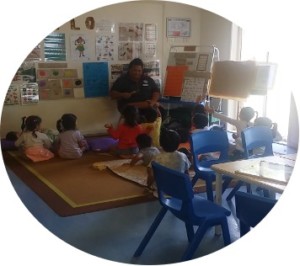Dr Kerry Taylor-Leech (from GIER) and Eseta Tualaulelei (from USQ) have been featured in a special issue of the journal TESOL in Context Vol. 30 No. 1: Languages in Early Childhood Education containing their article ‘Knowing who you are: Heritage language, identity, and safe space in a bilingual kindergarten’.
Their research explored the benefits and impacts of a bilingual Samoan-English kindergarten programme (a’oga amata). The a’oga amata, which was set up by a large community church in a socially disadvantaged area, was funded by an Australian government community initiative and hosted by a national non-profit early learning provider.
 Dr Taylor-Leech says:
Dr Taylor-Leech says:
“The academic team at Griffith was first approached by representatives of the government-funded initiative and the community church. In our preliminary meetings, our partners stated their desire for the a’oga amata to foster a strong sense of Samoan identity, develop children’s competence in their heritage language, and assist the children’s successful transition to school. It was important to our partners that the children in the a’oga amata felt culturally safe and we were asked to assess whether and how the a’oga amata was able to support these aspirations.”
The research found important benefits from the bilingual kindergarten programme. The a’oga amata promoted values and aspects of Samoan culture and language that were important to the children, the families and their communities. By providing curriculum-aligned learning experiences and activities that were culturally responsive, the a’oga amata nurtured the children’s sense of belonging and provided continuity between the home and care/educational environment. In addition, the Samoan parents’ attitudes to their heritage language became much more positive as their children brought it home.
However, there were also limitations, which included the limited range of Samoan language resources that minoritised both the educators and the heritage language. There was evidence that the a’oga amata catered for cultural but not linguistic diversity, and that there would be no support for Samoan (or any other heritage languages) once the children moved on. As the a’oga amata educators recognised, without strong, consistent support from home, the children would quickly lose what they had learned when they transitioned into the English-speaking school environment.
 From a language policy perspective, the positioning of the a’oga amata in an English-monolingual early learning centre as an exception, in which educators were ‘allowed’ to use Samoan and enact their culture, indicates an attitude of tolerance rather than the inclusion and promotion of bilingualism. The asymmetries between English and Samoan meant that the children’s exposure to Samoan was ultimately limited. Not long after the study ended, the a’oga amata left the provider’s premises and relocated to the church community centre.
From a language policy perspective, the positioning of the a’oga amata in an English-monolingual early learning centre as an exception, in which educators were ‘allowed’ to use Samoan and enact their culture, indicates an attitude of tolerance rather than the inclusion and promotion of bilingualism. The asymmetries between English and Samoan meant that the children’s exposure to Samoan was ultimately limited. Not long after the study ended, the a’oga amata left the provider’s premises and relocated to the church community centre.
The study concluded that policies which support community desires for heritage language education are needed to allow heritage languages to flourish. In its present form, the Early Years Learning Framework for Australia, which informs and guides early childhood education, does not go beyond rhetoric to provide specific guidelines and training requirements for supporting home languages, valuing children’s linguistic heritage and fostering bilingualism.
The academic partners in this research
- Griffith University: Dr Kerry Taylor-Leech, Dr Monika Krajcovicova, Ms Temukisa Lealasola.
- University of Southern Queensland: Dr Eseta Tualaulelei.
We were also grateful for the support, mentoring and assistance of:
- Assoc. Prof. Rod Gardner, University of Queensland.
- Assoc. Prof. Judith Kearney, Griffith University.
The community partners in this research
Pastor Naomi Pelite, Ms Monica Mamea, Ms Cathy Kenny, Ms Marie Faamu, Ms Alofagia Mauinatu.


